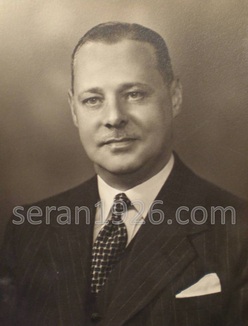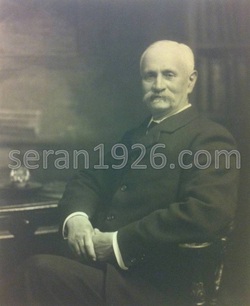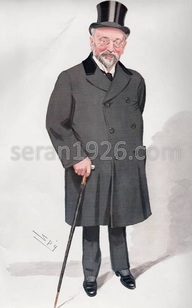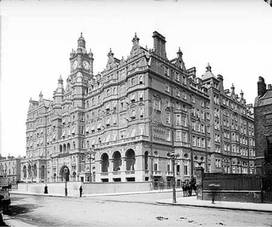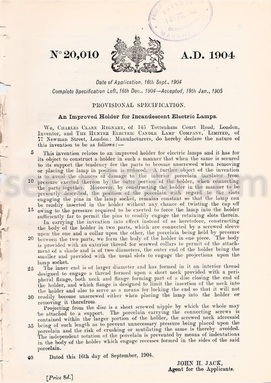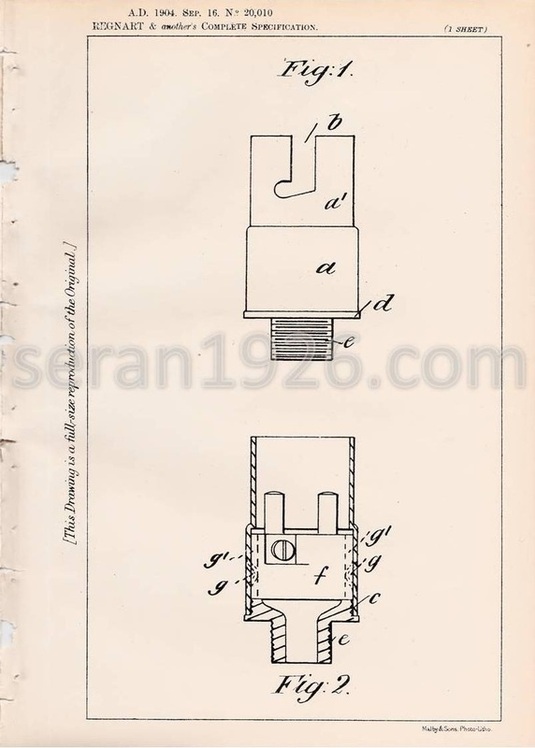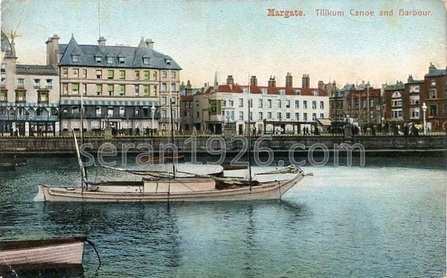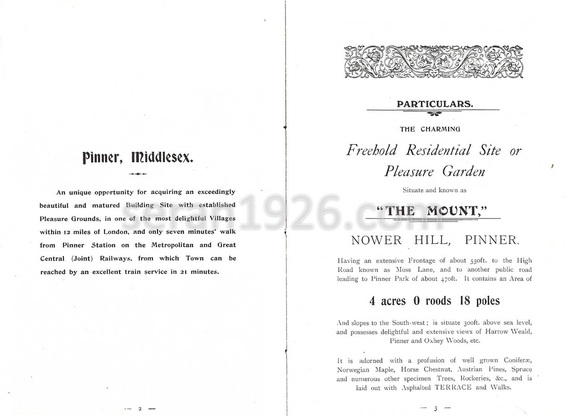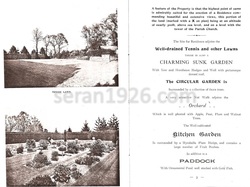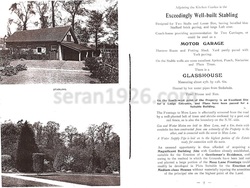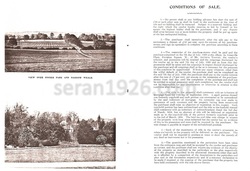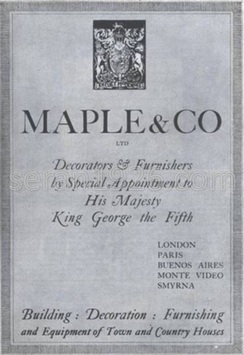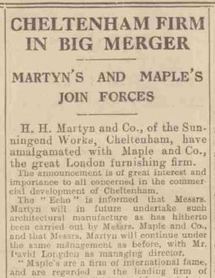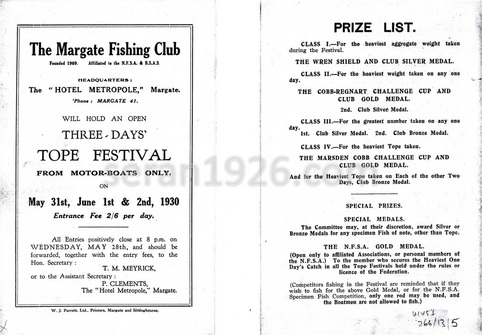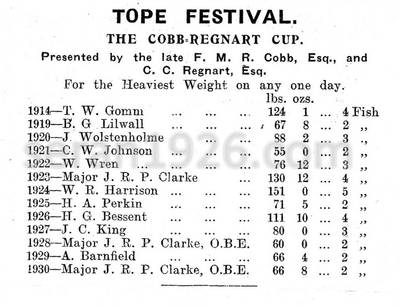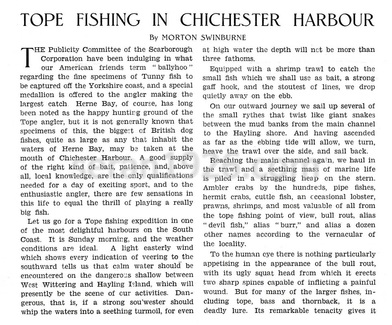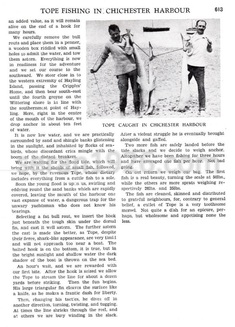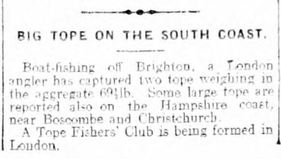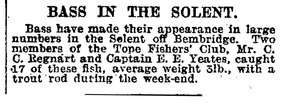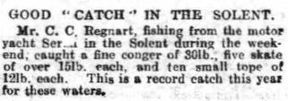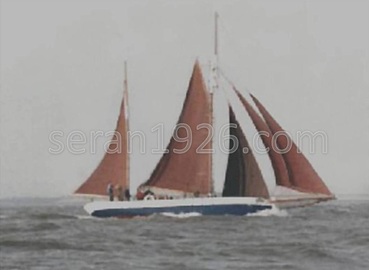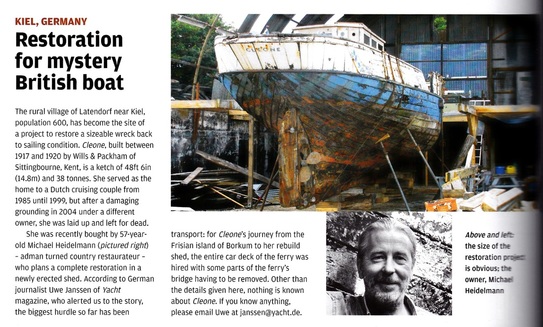Charles Clare Regnart
"Regnart, six foot tall and broad in the girth...walked along with his jacket undone, carrying all before him...every inch a President"
Maples Fine Furnishers: A Household Name for 150 Years, Hugh Barty King
Maples Fine Furnishers: A Household Name for 150 Years, Hugh Barty King
Charles Clare Regnart, also known as
Charles Hunter-Regnart, was born in 1876 in St. Pancras, Middlesex,
the second of six children. In 1881 the family were living at Hill House,
Winchmore Hill, before subsequently acquiring Stone Hall where Regnart’s
parents were to settle (Regnart’s brother, Horace, published his
recollections in “Memories of Winchmore Hill”, 1952).
The Maple's connection
His father, Clare Henry Regnart (1843 – 1932) and uncle,
Sir Horace Grece Regnart (1841 – 1912), had worked for Maple’s, the
furnishers of 145 Tottenham Court Road, since their arrival in London
from Jersey in the 1850’s and were promoted through the
ranks as the firm grew. In 1881 Regnart’s father was employed as a
carpet buyer for the company. In 1891 when Sir John
Blundell Maple formed a private limited company - which was
subsequently taken public in 1900 – both brothers were appointed
to the Board of Directors.
Following the death of Sir John Blundell Maple in 1903,
Clare Henry Regnart and Sir Horace Grece Regnart were elected respectively
President and Vice-President of Maple & Co. Ltd., the largest furnishing
establishment in the world, which, at this time, specialised in
large contracts for country houses, royal palaces, hotels and
theatre’s including The Hotel Cecil (1894), The Czar of Russia's
Winter Palace in St Petersburg (1897), The Royal Palace at Bangkok
for the King of Siam (c. 1900) and The Great Central Hotel in
Marylebone Road (c. 1900), to list but a few.
Early career
By 1901, aged twenty-five, Regnart was employed by Maple
& Co. Ltd., having trained as an electrical engineer with a particular
focus on domestic lighting. Domestic electric lighting was still a
relatively new technology at this time and between 1903 and 1914 Regnart
was granted some sixteen patents for modifications and
improvements to electric candle lamps, incandescent lamps and lamp holders,
registered in the name of ‘Charles C. Regnart’ and, in several
instances in 1904 and 1905, the ‘Hunter Electric Candle
Lamp Co.’
Regnart married in 1901 and around this time settled in
Margate, Kent. The birth of his daughter, Audrey Clare in 1904, led to the
family moving to Pinner, Middlesex the following year; firstly to
‘Dunkeld’, Elm Park Road and subsequently to 'Cardross’ on Paine
Lane. Despite moving from Margate, Regnart maintained a close association
with the town and in 1914 still owned a residence at 5, Royal York
Mansions, overlooking Margate harbour and a short walk from the jetty
(where the passenger steamer from London disembarked) and the Hotel
Metropole.
By 1908, Regnart had been appointed a Director
of the Board of Maple & Co. Ltd. The following year he acquired a
four acre site in Pinner suitable for a “Gentleman’s residence”
called ‘The Mount’ and, by 1912, had built a house on part of
the plot which he named Pinner Court. Interestingly, the
adjacent Nower Hill House was owned by Ambrose Heal (1847 – 1913), Chairman of
the firm Heal & Son Ltd. and a contemporary of Clare Henry Regnart and
Sir Horace Grece Regnart in the furniture industry of Tottenham Court
Road. His son, Sir Ambrose Heal (1872 - 1959) also lived in the
immediate vicinity, at 'The Fives Court' on Moss Lane, an arts
and crafts house designed by Cecil Brewer in 1900.
For a number of years therefore, Regnart was a neighbour of
both Ambrose Heal (until 1913) and Sir Ambrose Heal (until 1917, when he
moved to Beaconsfield). Following the death of Emily Maria Heal (Ambrose
Heals widow) in 1938, Regnart also acquired the adjacent 10 ¼ acre site of
Nower Hill House, which was to become his main residence until his death
in 1957 (although the property was requisitioned during the Second
World War).
First World War
|
By the outbreak of war in 1914 Maple’s had established
overseas operations in Paris (1905) and Buenos Aires (1906) and
had been granted contracts by King George V and Queen Mary,
Queen Alexandra, the Czar of Russia, the German Empress, the Empress Eugenie of
France, the King of Bulgaria, the Duke of Orleans, the Sultan of Zanzibar, the late
King of Siam and the royal families of Austria, Italy, Denmark, Belgium,
Spain, Portugal, the Netherlands, Norway and Sweden. In the “House of
Maple”, belatedly published in 1948 to mark the company’s
centenary, Regnart recalls how Maple’s vast resources were redirected to
supporting the war effort. “During the First World War all the factories
and a large part of the showrooms in the main premises were converted for
the production of war equipment, and all types of canvas stores were
produced to the value of many millions of pounds.”
|
During the War, Regnart was attached to the Middlesex
Motor Volunteer Corps. The 30 May 1918 edition of ‘Commercial Motor’
reported that the “Middlesex Motor Volunteers have organised the heavy
transport in the county which they represent, and have met with a most
patriotic response on the part of owners of mechanical transport, who have
freely allowed their cars and lorries to be enrolled... No. 3 Company of
the Central Group (M. M. V.) is not yet up to the full strength in drivers.
Captain Regnart, care of Messrs’ Maple and Co., Tottenham Court Road. W.,
will be glad to furnish further particulars to any owner-drivers who may
be interested."
Another intriguing episode during this period relates
to Regnart’s brother, Cyrus Hunter Regnart (1871 – 1921), also referred to
as ‘Roy’ or ‘Reggie’, a Captain in the Royal Marines Light Infantry
working within the Naval Intelligence Department. He was one was one
of the first 'spies' recruited into the newly formed Secret Intelligence
Service (latterly Mi6) reporting directly to Commander Mansfield Cumming.
At the start of the war, the S.I.S. had one foreign station operating out
of furniture shop in Brussels at 7, Rue de Garchard and it seems likely
that Cyrus Regnart exploited his family connections with Maple’s to establish
credible cover.
Post War Years
In his book “Maples Fine Furnishers: A Household Name for
150 Years” Hugh Barty-King observes that in the post war years,
the reputation of, and affection for, the Maple’s business
ensured that the store resumed its position as “One of the Sights of
London" and as "The Largest and Most Convenient Furnishing
Establishment in the World."
C. C. Regnart was elected President of Maple & Co.
Ltd. in March 1926, following his father’s retirement. Under his stewardship
the company continued to realise the huge potential in catering for
the growing middle classes, offering “modern tastes
at affordable prices.” Credit was available and advertised as “furnishing
out of income, a most attractive proposition.” This approach combined with
the gradual expansion of branches outside of London (such as the
Birmingham store in 1936) opened up new domestic markets which led to
rapid and continued growth through the 1930's. The Victorian frontage of the
Tottenham Court Road store was rebuilt in 1930, “more in conformity with
modern ideas” and “reflecting more adequately the enterprise of
the firm” (House of Maple, 1948).
In 1933 Maple’s acquired the Cheltenham based firm
H. H. Martyn & Co. who, from 1909, had been fitting out luxury ocean
liners. By 1933 the firm had undertaken thirty-six ship
interior decoration contracts, principally first class lounges and
foyers, staircases, smoking rooms and swimming pools and had built
the fluted columns on the 'Titanic' and worked on the refit of the
'Lusitania'. In 1934 Maple-Martyn's won the contract
for manufacturing and fitting 272 light fittings in silver
bronze, the first class main staircase and music practice room on the
'Queen Mary.' Although Maple's had some experience in this field -
for instance they had created the interior of the luxury yacht, 'Monarch
II' in 1922 - the highly skilled craftsmen of H. H. Martyn
allowed Maples to compete for contracts to
furnish ocean liners, which was both lucrative and complimentary
to Maples' traditional hotel contracts.
The Second World War
In 1936, with the prospect of War looming,
Regnart attended a lunch at the Trocadero restaurant hosted by The
Secretary of State for War. That year Maple’s started converting their
factories and showrooms for the production of war equipment so that when
war broke out, some 2,500 women were employed by the firm in the
manufacture of such equipment; significant contracts that continued
throughout the war years. At the AGM in March 1945, Regnart commented on the
firm’s contribution to the war effort:
“It may surprise you to know the varied range of stores which we actually manufactured during these war years, and also that we have operated in no less than 16 factories dispersed throughout the country – tents of every design and description by the hundreds of thousands, including those especially for tropical and snow warfare, canvas shelters and aeroplane hangars, covers for guns of every type for tanks and lorries, bridging camouflage and all types of webbing equipment.
Great quantities of bedding, jungle warfare necessities, gaiters, anklets, water bottles, mosquito and sand-fly nets and tents and even clothing in the form of tropical outfits and leather jerkins, and I must add the Service gas-mask haversack, where we reached the record output of any firm in the Allied world, 100,000 per week, but what may surprise some of you even more who are not intimately acquainted with the ramifications of this business, is that from the very earliest days of the war we have also been engaged on the manufacture of aircraft component parts which embrace such well-known names as Hurricane, Mosquito, Typhoon, Lancaster, Wellington, and gliders, besides many others, whilst orders have been executed for gun and torpedo parts and even light coastal craft..." (The Times, 10 April 1945). |
In this context it’s not surprising that the
firm’s premises were extensively bombed during the war and much of the
Tottenham Court Road store was destroyed in April 1941.
In the post war years Maple’s faced a shortage of skilled labour and government controls but the former H. H. Martyn’s business continued to generate income for Maple’s in the rebuilding work that followed. Regnart retired as President in 1953 having held the position for twenty-seven years.
Sea Angling and Yachting
Regnart was a keen sea angler and member of the Margate Fishing Club in the years leading up to the First World War. At this time, sea angling as a sport, organised under the auspices of The British Sea Anglers' Society (founded in 1893), was relatively new. In 1914 Regnart, jointly with well known Margate businessman F. M. R. Cobb, gifted the Cobb-Regnart Challenge Cup which was presented annually at the club’s Tope Festival until it was won outright in 1930.
'Mavourneen', 1911
From 1914, Regnart was the registered owner of ‘Mavourneen’ a 26 ft., 4 ton, motor launch built in 1911 by Rogers & Co., Plymouth which he owned until at least the mid 1920’s. It seems likely that he fished from her in the Thames Estuary off the north Kent coast.
'Seran', 1926
In the post war period, Regnart remained an enthusiastic angler but appears to have focussed on the fishing grounds off the coast of the Isle of Wight and the Solent. From the mid 1920s and through the 1930s large mackerel shoals were to be found in abundance off the south coast of England from the Isle of Wight to Margate, and with these shoals, large numbers of predatory tope.
In early June 1925, under the heading "Big tope on the south coast" the Portsmouth Evening News reported large specimens had been landed on the Hampshire Coast, near Boscombe and Christchurch and that a Tope Fishers' Club was to be formed in London, whose membership was to comprise "members of Parliament, champagne merchants, stockbrokers and so on". (Daily mail 28 April 1938).
Regnart was an early member of the Tope Fishers' Club and it seems probable that 'Seran' was commissioned in March 1926 primarily for tope fishing on the south coast.
In March 1926 Regnart, by now a member of the British Motor Boat Club, approached Halliday to design ‘Seran’, a twin screw motor yacht with a large open cockpit designed for sea angling with storage for rods, nets and trawls. One of Seran’s unusual features was the installation of twin Ailsa Craig ‘L6’ 16/20-hp engines, suggesting coastal cruising over reasonable distances, during which a second engine would provide some comfort in the event of mechanical failure.
Interestingly, a motor yacht fitted with twin Ailsa Craig ‘L6’ engines, of almost identical dimensions to ‘Seran’ (34 ft. 6 ins. L.O.A., 8 ft. 6 ins. beam, 2 ft. 7 ins. draught) and built by the Walton-on-Thames Launch Co. was exhibited at the Shipping, Machinery and Engineering Exhibition at Olympia in December 1925, designed “specially for cruising in the French canals” and it seems possible at least, that this design was the inspiration for ‘Seran’. Traces of copper sheathing on the hull suggest Regnart may have taken ‘Seran’ to the Mediterranean during this period.
In May 1927 the Daily Mail reported the success of two members of the Tope Fishers' Club; Regnart and Captain E E Yeats (the club's Hon. Secretary), bass fishing in the Solent off Bembridge. In July 1928, The Times reported Regnart catching a record haul in the Solent, this time aboard the motor yacht 'Seran'.
In 1934 Regnart had ‘Seran’ re-constructed: extended 5 ft. with the addition of the canoe stern, fitted with a single, low rectangular cabin and a higher bow to help prevent heavy water coming on board. Taken together these modifications suggest a change of intended use focussed on extended, coastal cruising.
The Tope Fishers' Club remained active throughout the 1930's but the arrival of thresher sharks off the south coast in early 1938 shifted the focus to shark angling:
"A number of anglers accustomed to tope fishing have decided to take up thresher shark angling during the coming season. It is proposed to form a Thresher Shark Fishers' Club, with Captain E. E. Yeats, the former honorary secretary of the Tope Fishers' Club, as secretary".
The article goes on to provide an interesting insight into the club:
"The sport of shark fishing off the south coast will be pursued by a body of about 50 anglers, most of whom are London business men. They will devote week-ends and periods of summer holidays to the sport. Motor-boats or sailing craft of about 5 tons each will carry the fishermen on their adventurous expeditions. Normally, a boat's crew will consist of two anglers and one or two boatmen. The fishers will make for a point 10 miles from the shore... They will operate from Newhaven, which is considered a good centre and from Poole and other ports, and the fishing ground will stretch to the Isle of Wight and Margate". (The Times, 29 April 1938).
'Cleone' (ex 'Fred and Dan'), 1920
In 1929 Regnart acquired the ‘Cleone’ a 40 ft. converted gaff ketch trawler of 40 ft., built in 1920 by Wills & Packham, Sittingbourne. Commissioned by the Ministry of Agriculture and Fisheries, 43, Parliament Street, London SW1, she was originally named ‘Fred and Dan’ and registered with the Port of Ramsgate in 1920 with Official No. 137716. In 1923 ownership passed to an Arthur Davey of Bradford, although it seems she remained at Ramsgate. In 1925 she was sold to the Right Hon. Lord Tredegar and re-registered with the Port of Glasgow, before passing to Hollingworth B. Magniac in 1928. During his short ownership she was converted to an auxiliary yacht, re-named ‘Cleone’ and re-registered with the Port of Cowes retaining her Official No.
Regnart appears to have cruised extensively along the
south coast in ‘Cleone’ employing the services of an experienced skipper,
Benjamin Chaplin. In the late 1930’s ‘Cleone’ was recorded at Fowey, off the
Dorset Coast and at a number of events at Cowes. Failing health led
Regnart to part with ‘Cleone’ in 1955 after twenty-six years of ownership.
By 2004, ‘Cleone’ had sunk at her moorings on the
Frisian island of Borkum and between 2004 and 2011 was kept on
hard standing. In August 2011 she was acquired by Michael Heidelmann
and moved to Latendorf, near Kiel where she is currently
being restored.
'Jolie Brise', 1939
In 1939 Regnart and his paid skipper, Benjamin
Chaplin, commissioned the 'Jolie Brise', a traditional Essex sailing smack
of 30 ft. L.O.A., 11 tons and fitted with an auxiliary 2 cylinder
diesel engine. She was built by C. Kidby & Son,
Brightlingsea, which, interestingly was Chaplin’s childhood home. Chaplin
was a keen sea angler and yacht master and following Regnart’s death
in 1957, sole ownership of the ‘Jolie Brise’ passed to him.
"Counter sterned cutter smacks also worked from Cowes; the last being the Essex-built 'Jolie Brise' sailed by Mr. Ben Chaplin until 40 years ago." "The Gaff Rig Handbook: History, Design, Techniques, Developments" (2001).
